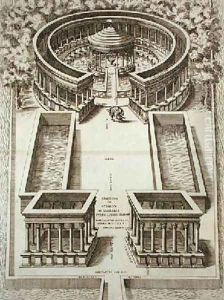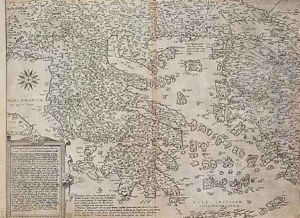Ligorio, Piero Paintings
Pirro Ligorio was an Italian architect, painter, antiquary, and garden designer who played a significant role in the Italian Renaissance. Born in Naples in 1512, Ligorio is best known for his work in the realm of architecture and for his contributions to the Villa d'Este in Tivoli. His career, however, encompassed a variety of artistic and scholarly activities, reflecting the Renaissance ideal of the polymath who excels in multiple fields.
Ligorio's early life and training are not well documented, but it is known that he moved to Rome in the 1530s. There, he became deeply involved in the study of ancient Roman art and architecture. He was particularly fascinated by ancient inscriptions and developed a reputation as an accomplished antiquary, producing drawings and interpretations of Roman ruins. This expertise led to his involvement in the construction and decoration of some of the most significant buildings of the Renaissance.
In 1550, Ligorio was appointed as the architect of the Vatican by Pope Julius III, and after the death of Michelangelo, he took over as the superintendent of antiquities in Rome. One of Ligorio's most famous projects was the completion of the Casino of Pius IV in the Vatican Gardens. His work reflects a unique blend of classical antiquity and contemporary Renaissance style, which was often characterized by imaginative designs that sometimes diverged from strict classical precedents.
The pinnacle of Ligorio's career as a garden designer was his work at the Villa d'Este in Tivoli, which he began in 1560 for Cardinal Ippolito II d'Este. The villa's gardens are a masterpiece of Italian Renaissance garden design, featuring an array of fountains, nymphs, grottoes, and water features ingeniously integrated with the sloping terrain. The Villa d'Este's gardens had a profound impact on European garden design and are considered one of Ligorio's crowning achievements.
Aside from his architectural and garden design work, Ligorio also made contributions to the field of cartography and was involved in the design of maps. His interests in archaeology and history resulted in several publications on the topic of ancient Roman monuments and inscriptions.
Pirro Ligorio's legacy as an architect and designer is marked by his innovative approach to combining classical elements with the Renaissance spirit of his time. His work influenced subsequent generations of architects and garden designers. Ligorio passed away in Ferrara on October 30, 1583. The Villa d'Este, arguably his most famous legacy, was designated a UNESCO World Heritage Site in 2001, attesting to the enduring significance of his work.

